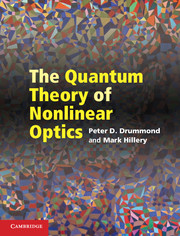Book contents
- Frontmatter
- Contents
- Preface
- Introduction
- 1 Classical nonlinear optics
- 2 Field quantization
- 3 Quantized fields in dielectric media
- 4 Microscopic description of media
- 5 Coherence and quantum dynamics in simple systems
- 6 Decoherence and reservoirs
- 7 Phase-space distributions
- 8 Single-mode devices
- 9 Degenerate parametric oscillator
- 10 Quantum field dynamics
- 11 Quantum propagation in fibers and waveguides
- 12 Quantum information
- List of symbols
- Index
- References
12 - Quantum information
Published online by Cambridge University Press: 05 May 2014
- Frontmatter
- Contents
- Preface
- Introduction
- 1 Classical nonlinear optics
- 2 Field quantization
- 3 Quantized fields in dielectric media
- 4 Microscopic description of media
- 5 Coherence and quantum dynamics in simple systems
- 6 Decoherence and reservoirs
- 7 Phase-space distributions
- 8 Single-mode devices
- 9 Degenerate parametric oscillator
- 10 Quantum field dynamics
- 11 Quantum propagation in fibers and waveguides
- 12 Quantum information
- List of symbols
- Index
- References
Summary
Quantum information, which studies the representation of information by quantum mechanical systems and the type of information processing this makes possible, is a relatively new field. Its roots, however, go back to early discussions of the interpretation of the quantum mechanical formalism. In 1935 Einstein, Podolsky and Rosen suggested that there were interpretational issues with quantum mechanics, having to do with local realism. Einstein was puzzled by an apparent lack of locality in quantum mechanical descriptions of reality, and suggested that quantum mechanics was not a complete theory. This stimulated a subsequent series of theoretical and experimental investigations. In particular, John Bell realized that Einstein's proposal for a ‘completion’ of quantum mechanics by the addition of more variables – called ‘hidden’ variables – was not consistent with quantum predictions, and could not be carried out.
While these interpretational issues set the stage for what followed, the modern field of quantum information arose in the 1980s stimulated by the ever decreasing size of the elements in information processing circuits. It was realized that at some point a threshold would be crossed and the devices would start to exhibit quantum mechanical behavior. It was first determined that, if they did, it would not present a problem, and, in addition, it could even be advantageous. This led to the idea of a quantum computer that stores information in quantum states, or ‘qubits’, rather than as binary digits, or ‘bits’, in a standard digital computer.
The field took off when, in 1994, Peter Shor found an efficient quantum algorithm for finding the prime factors of an integer.
- Type
- Chapter
- Information
- The Quantum Theory of Nonlinear Optics , pp. 346 - 368Publisher: Cambridge University PressPrint publication year: 2014



